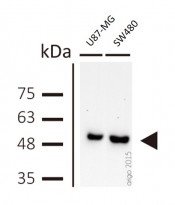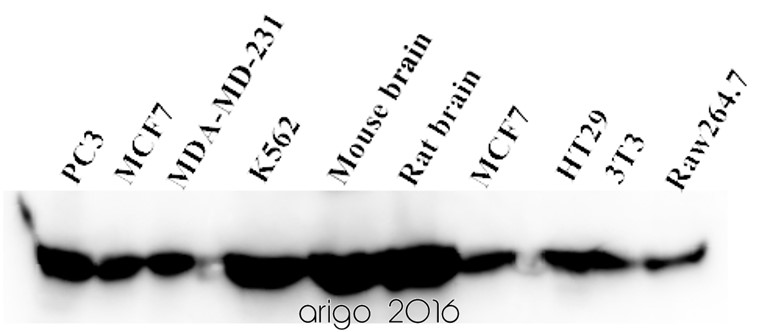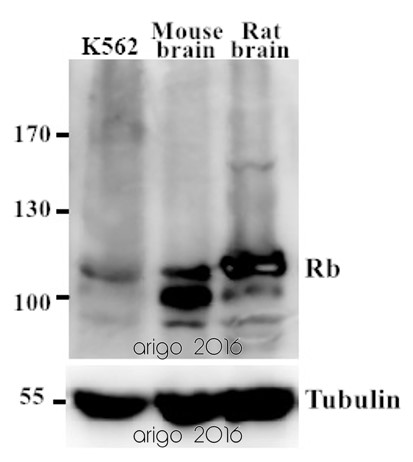ARG62347
anti-beta Tubulin antibody [BT7R]
anti-beta Tubulin antibody [BT7R] for Dot blot,ELISA,ICC/IF,Western blot and Human,Mouse,Rat,Chicken,Monkey,Rabbit
Controls and Markers antibody; Signaling Transduction antibody

Overview
| Product Description | Mouse Monoclonal antibody [BT7R] recognizes beta Tubulin |
|---|---|
| Tested Reactivity | Hu, Ms, Rat, Chk, Mk, Rb |
| Tested Application | Dot, ELISA, ICC/IF, WB |
| Specificity | Recognizes native and denatured forms of beta Tubulin (about 50 kDa). |
| Host | Mouse |
| Clonality | Monoclonal |
| Clone | BT7R |
| Isotype | IgG2a |
| Target Name | beta Tubulin |
| Antigen Species | Human |
| Immunogen | KLH-conjugated synthetic peptide around the N-terminal region of Human beta Tubulin. |
| Conjugation | Un-conjugated |
| Alternate Names | Tubulin beta-1 chain |
Application Instructions
| Application Suggestion |
|
||||||||||
|---|---|---|---|---|---|---|---|---|---|---|---|
| Application Note | * The dilutions indicate recommended starting dilutions and the optimal dilutions or concentrations should be determined by the scientist. | ||||||||||
| Positive Control | Mouse brain tissue lysates |
Properties
| Form | Liquid |
|---|---|
| Purification Note | Protein A affinity chromatography from Mouse ascites fluid. |
| Buffer | 10mM PBS (pH 7.2) and 0.05% Sodium azide |
| Preservative | 0.05% Sodium azide |
| Concentration | 1 mg/ml |
| Storage Instruction | For continuous use, store undiluted antibody at 2-8°C for up to a week. For long-term storage, aliquot and store at -20°C or below. Storage in frost free freezers is not recommended. Avoid repeated freeze/thaw cycles. Suggest spin the vial prior to opening. The antibody solution should be gently mixed before use. |
| Note | For laboratory research only, not for drug, diagnostic or other use. |
Bioinformation
| Database Links | |
|---|---|
| Gene Symbol | TUBB1 |
| Gene Full Name | tubulin, beta 1 class VI |
| Background | Beta tubulins are one of two core protein families (alpha and beta tubulins) that heterodimerize and assemble to form microtubules. This protein is specifically expressed in platelets and megakaryocytes and may be involved in proplatelet production and platelet release. A mutations in this gene is associated with autosomal dominant macrothrombocytopenia. Two pseudogenes of this gene are found on chromosome Y. [provided by RefSeq, Jul 2010] |
| Function | Tubulins is the major constituent of microtubules. It binds two moles of GTP, one at an exchangeable site on the beta chain and one at a non-exchangeable site on the alpha chain. [UniProt] |
| Cellular Localization | Cytoplasm › cytoskeleton |
| Highlight | Related Antibody Duos and Panels: ARG30330 Pyroptosis Antibody Panel Related products: beta Tubulin antibodies; beta Tubulin Duos / Panels; Anti-Mouse IgG secondary antibodies; |
| Research Area | Controls and Markers antibody; Signaling Transduction antibody |
| Calculated MW | 50 kDa |
| PTM | Some glutamate residues at the C-terminus are polyglutamylated, resulting in polyglutamate chains on the gamma-carboxyl group (PubMed:26875866). Polyglutamylation plays a key role in microtubule severing by spastin (SPAST). SPAST preferentially recognizes and acts on microtubules decorated with short polyglutamate tails: severing activity by SPAST increases as the number of glutamates per tubulin rises from one to eight, but decreases beyond this glutamylation threshold (PubMed:26875866). Some glutamate residues at the C-terminus are monoglycylated but not polyglycylated due to the absence of functional TTLL10 in human. Monoglycylation is mainly limited to tubulin incorporated into axonemes (cilia and flagella). Both polyglutamylation and monoglycylation can coexist on the same protein on adjacent residues, and lowering glycylation levels increases polyglutamylation, and reciprocally. The precise function of monoglycylation is still unclear (Probable). Phosphorylated on Ser-172 by CDK1 during the cell cycle, from metaphase to telophase, but not in interphase. This phosphorylation inhibits tubulin incorporation into microtubules. |
Images (4) Click the Picture to Zoom In
-
ARG62347 anti-beta Tubulin antibody [BT7R] WB image
Western blot: Rat basolateral amygdala stained with ARG62347 anti-beta Tubulin antibody [BT7R] at 1:1000 dilution, ARG65350 Goat anti-Mouse IgG antibody (HRP) at 1:5000 dilution.
From Guang-Bing Duan et al. CNS Neurosci Ther. (2024), doi: 10.1111/cns.14611, Fig. 4.D.
-
ARG62347 anti-beta Tubulin antibody [BT7R] WB image
Western blot: 20 μg of PC3, MCF7, MDA-MD-231, K562, M. brain, R. brain, MCF7, HT29, 3T3 and Raw264.7 cell lysates stained with ARG62347 anti-beta Tubulin antibody [BT7R] at 1:3000 dilution.
-
ARG62347 anti-beta Tubulin antibody [BT7R] WB image
Western blot: 20 µg of 293T, Mouse brain and Rat brain lysates stained with ARG62347 anti-beta Tubulin antibody [BT7R] at 1:10000 dilution.
-
ARG62347 anti-beta Tubulin antibody [BT7R] WB image
Western blot: U87-MG and SW480 cell lysates stained with ARG62347 anti-beta Tubulin antibody [BT7R] at 1:1000 dilution.
Customer's Feedback
 Excellent
Excellent
Review for anti-beta Tubulin antibody [BT7R]
Application:WB
Sample:PC3, MCF7, MDA-MD-231, K562, M. brain, R. Brain, MCF7, HT29, 3T3, and Raw264.7
Sample Loading Amount:20 µg
Primary Antibody Dilution Factor:1:3000
Primary Antibody Incubation Time:overnight
Primary Antibody Incubation Temperature:4 ºC
Specific References









 Good
Good







